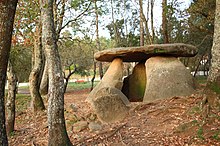Ría de Muros e Noia is the northernmost inlet of the Rias Baixas on the Atlantic west coast of Galicia.
Regions


The northernmost inlet of the Rias Baixas, a fjord-like sunken river mouth on the western Atlantic coast of Galicia, is known as the Ría de Muros e Noia - depending on whether the ría of Muros on the north coast or from the town Noia is viewed from the western end.
The ría is formed by Rio Tambre the one from the north of Santiago de Compostela The coming river flows into a marshland in the west of the Ría.
At the confluence of another smaller river, the one that became marshy at the confluence Rio Tallare is the town Noia (span. "Noya").
At low tide, the Atlantic retreats a long way in the estuary and leaves behind a muddy landscape.
places

- the city Noia (or "Noya" in Spanish) is located at the western end of the inlet. Most of the shops and service providers can be found in the small town with around 14,000 inhabitants.
- to the north is the town Muros with its approx. 9,500 inhabitants
- the villages are located on the southern coast of the Ría Portosín and Porto do Son and other small towns.
Other goals
There are numerous sandy beaches between the places, some with more, some with less infrastructure.
language
Is spoken Galician (Gallego), one with that Spanish Related idiom, which is strongly related to the soft one from the pronunciation Portuguese remind; Above all, younger residents who like to apply their school knowledge have a knowledge of English.
getting there
Of Santiago de Compostela, which at the ![]() Autovía A-9 lies, will Noia about the AC-543 or the new expressway under construction CG-1.5 reached.
Autovía A-9 lies, will Noia about the AC-543 or the new expressway under construction CG-1.5 reached.
The coastal road leads along the coast AC-550 north towards Cabo Fisterra and south up Ribeirafrom where they as AG-11 continues. Since the coastal road meanders along all the bays, longer travel times are to be assumed for relatively short straight-line distances ("just quickly to the opposite side of the Ría" can take two hours ...).
With Santiago is Noia connected by bus. The railway line from Santiago to Vigo leaves the region on the left.
mobility
Although bus traffic is quite well developed, the best way to get around is with your own (motor) vehicle, cycling can be challenging in sometimes windy conditions and roads leading up and down.
Tourist Attractions



Next to the town Noia and the beaches of the Ría is the Celtic Castro de Baroña, the Dolmen de Axeitos and the nature reserve with the Corrubedo giant dune worth seeing, from Mirador de la Curota on a mountain flank you have a great view of the ría and the adjoining one in the south Ría de Arousa.
activities
The beaches on the not quite so rough ría with the slightly more pleasant water temperatures than on the unprotected Atlantic coast invite you to swim and do water sports.
kitchen
The typical Galician cuisine with their Empanadas, filled dumplings, and stew dishes stand out from the cliché of the Spanish paëlla, which doesn't exist in this country.
nightlife
Outside of the towns of Noia and Muros, it is very leisurely to and fro.
security
The security situation in this very rural region is harmless, as in all of Central Europe, petty crime must be expected.
climate
The climate on the Atlantic coast is a little less harsh than in the north, but even in summer there are frequent downpours on the west coast in the foothills of the mountain ranges that separate Galicia from the brooding Spanish heartland. In Galicia, even in midsummer, one encounters lush green meadows and forests (even if these were often reforested with eucalyptus).
The climate is reminiscent of that Brittany or the south of England, where you can occasionally stand under a palm tree in the rain, as there is hardly any frost in winter.
